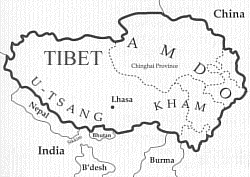|
|
Background
Information

In the last years of the 1980's a river of over two hundred
Tibetan Buddhist nuns began to flow into the exiled Tibetan communities
of India and Nepal. Most of them started their lives as farm girls,
spending days full with the work of growing barley and wheat, tending
yak and sheep, and caring for younger children. All of them, however,
stopped and stepped aside. Leaving behind hopes for marriage and motherhood
they chose a life of celibacy, study, and religious devotion.
The nuns in Tibet set themselves upon a
difficult, sometimes harsh path. Only a handful of nunneries have been
rebuilt after the destruction from the Chinese invasion of Tibet and
the years of the 'Cultural Revolution'. Nuns must often live and practice
independently, without the support and nurture of a religious community
and without access to teachers. Those who have joined nunneries find
themselves cleaning up debris and rebuilding temples and rooms. They
are left with little time for religious ritual or study. Nuns also find
themselves embroiled in a confrontation between Tibetan cultural and
religious practice, and antagonistic Chinese imperialism. Chinese officers
assigned to each nunnery impose political education sessions. Political
informers create a climate of fear and hostility. Often, the nuns cannot
travel on pilgrimage, attend teachings, or even decide daily schedules
without Chinese permission. A nun's life is necessarily a statement
of opposition to Chinese occupation and control, while it is also an
affirmation of Tibetan culture. Ideals of compassion and sacrifice,
combined with a belief in the right to practice Buddhism freely and
fully, create a tremendous will to free Tibet from China. For these
women, religious freedom means Tibetan freedom. Demonstrations are born
of frustration and indignation. Far from the grand scale of Tienanmen
Square, they are often small gestures of defiance. A nun will step onto
a box in the central marketplace of Lhasa and pull out a Tibetan flag
from her robes; a small group will go into the city at night and put
up posters they have written in hiding, or begin shouting slogans while
circling the Jo Khang temple.
The nuns describe success in terms of how
many times they make it around the Jo Khang before being arrested, because
arrest is almost inevitable. They know what awaits them. Such knowledge
transforms small, and seemingly futile, gestures into acts of profound
courage. Imprisonment lasts for a few months to as much as three years.
It means torture, repeated interrogation, humiliation, and deprivation.
Interrogators inevitably ask for the names of leaders, but few nuns
talk, not only because of their commitment and strength, but because
there are no leaders. It is a movement without organization, a spontaneity
fired by desperation. After imprisonment and expulsion from the nunneries,
nuns often remain under house arrest. They are forbidden to join in
community events and are fined for any external sign of religious practice.
Denied ration cards and the permits necessary to earn a living, they
become burdens on their families and are isolated from the rest of the
community. Many decide to come to India, drawn to the protection and
hope of His Holiness the Dalai Lama and the Tibetan community in exile.




Return
to Main page | Specific Projects
| The Nuns | Donations
& Sponsorships
Now
Available - Tibetan Nuns Calendar 2001!
All
material copyright © The Tibetan Nuns Project.
|